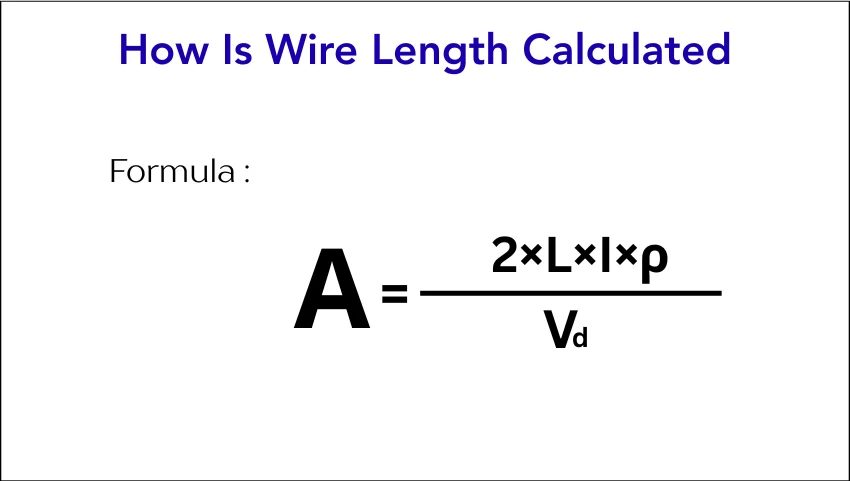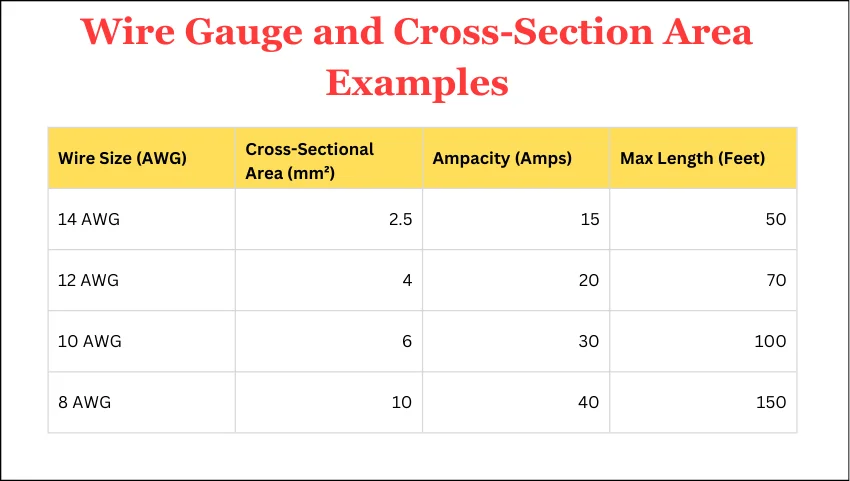Wire Size Calculator
Calculate the correct electrical wire gauge for your project
How to Use This Calculator
1. Select your electrical system type (DC/AC single-phase or AC three-phase)
2. Enter the source voltage of your system
3. Set the allowable voltage drop percentage (typically 3-5%)
4. Choose your conductor material (copper or aluminum)
5. Input the peak current your system will draw
6. Enter the one-way distance from source to load
7. Set the maximum operating temperature
8. Click calculate to get your wire size recommendation
Proper electrical wiring is essential for safety, efficiency, and durability in any electrical project. One of the critical factors in wiring is choosing the correct wire size. This article provides an easy-to-understand guide on wire size calculation, detailing the importance of proper wire sizing, technical factors involved, usage of wire size calculators, and tips for various applications.
What Is a Wire Length Calculator?
A wire length calculator is a practical tool designed to help determine the appropriate wire gauge for electrical wiring projects. It considers various essential factors such as current load (amps), voltage, wire length, and allowable voltage drop to recommend the right wire size.

Using the correct wire size is crucial to prevent overheating, reduce energy loss, and ensure that electrical equipment operates safely and efficiently. Wire length calculators utilize standards like the American Wire Gauge (AWG) and apply electrical formulas to measure ampacity and voltage drop requirements accurately.
Why Is Proper Wire Sizing Important?
Proper wire sizing is vital because:
- Overheating Prevention: Undersized wires can become dangerously hot, creating fire hazards.
- Voltage Drop Minimization: Excessive voltage drop reduces electrical efficiency and can damage sensitive devices.
- Reduced Energy Loss: Larger wires lower resistance, saving energy and enhancing the system’s performance.
Incorrect wire size may lead to equipment failure, inefficiency, and safety risks. Thus, a wire size calculator simplifies the process by ensuring installations are compliant with safety codes and operational requirements.
Key Technical Factors in Wire Length Calculation
Several technical factors influence the wire length needed for an electrical circuit:
1. Ampacity
Ampacity refers to the maximum current a wire can safely carry without overheating. For example:
- 14 AWG wire typically supports up to 15 amps.
- 10 AWG wire typically supports up to 30 amps.
The ampacity depends on the wire material and insulation type. Wire gauge charts provide a quick reference for different sizes and their ampacity ratings.
2. Voltage Drop
Voltage drop is the loss of voltage as electricity travels through a wire due to resistance. It is usually expressed as a percentage of the total voltage.
- A typical acceptable voltage drop limit is 3%.
- Longer wires or wires carrying large currents require larger diameters to minimize voltage drop.
Voltage drop is critical in DC circuits and long cable runs where resistance effects are more pronounced.
3. Wire Length
The longer the wire, the thicker it needs to be. This is because resistance increases with length, which can cause overheating and voltage drops. Using a wire size calculator helps factor in the distance automatically.
4. Wire Material
The most common materials for electrical wires are copper and aluminum:
- Copper has high electrical conductivity, allowing smaller wire sizes for the same current.
- Aluminum is lighter but requires larger-gauge wires to carry the same current safely.
Choosing the correct conductor material affects the wire size and cost.
How Is Wire Length Calculated?
Wire length depends on the cross-sectional area of the conductor, which determines its capacity to carry current without excessive voltage drop or overheating.

The cross-section area AAA can be calculated using the formula derived from Ohm’s law and resistive properties: A=Vd2×L×I×ρ
Where:
- LLL = length of cable (one-way),
- III = current in amperes,
- ρ\rhoρ = resistivity of the conductor,
- VdV_dVd = allowable voltage drop (in volts).
The result AAA is usually expressed in square millimeters (mm²).
This helps ensure the conductor can safely handle the electrical load and distance without risk.
How to Use a Wire Length Calculator
Wire size calculators Simplify this complex calculation through easy input steps:
- Select Electrical System Type: DC/AC single-phase or AC three-phase.
- Enter Source Voltage: Example, 120 V or 230 V.
- Input Allowable Voltage Drop Percentage: Typically 3% to 5%.
- Choose Wire Material: Copper or Aluminum.
- Enter Current Load (amps): The maximum expected current.
- Enter Cable Length: One-way length from source to load.
- Set Operating Temperature: Maximum expected wire temperature.
The calculator then outputs:
- Recommended wire gauge (e.g., 14 AWG, 10 AWG, etc.),
- Cross-sectional area in mm²,
- Wire diameter,
- Often the next largest size to ensure a safety margin.
Wire Gauge and Cross-Section Area Examples

| Wire Size (AWG) | Cross-Sectional Area (mm²) | Ampacity (Amps) | Max Length (Feet) |
|---|---|---|---|
| 14 AWG | 2.5 | 15 | 50 |
| 12 AWG | 4.0 | 20 | 70 |
| 10 AWG | 6.0 | 30 | 100 |
| 8 AWG | 10 | 40 | 150 |
Important: Always round up to a thicker wire for safety, especially for longer circuits or high-power loads.
Differences in AC and DC Wire Length
- In DC circuits, voltage drop can be more significant due to the nature of direct current, requiring larger wire sizes for the same current and distance.
- For AC circuits, especially three-phase systems, the calculations adjust for the phase currents and typically require less wire size than DC for the same load.
Wire length calculators often include options for both, making it simple to get accurate recommendations.
Special Applications of Wire Length Calculators
Load Calculation for Electric Vehicle (EV) Chargers
EV chargers draw high current loads. Proper wire size is necessary to handle the peak load safely and comply with regulations. Wire size calculators help determine cable size considering the specific charger rating and cable distance.
Solar Power Systems
For solar installations, wire size calculators compensate for DC voltage drop and distance to ensure batteries and inverters receive sufficient power without losses.
Motor Wiring
Motors can have high starting currents. Wire length calculators for motors consider the motor load factor to recommend a larger wire gauge accordingly.
Tips for Choosing Wire Length
- Always consider the maximum current the wire will carry, not just the nominal load.
- Factor in the length of the cable run carefully to avoid excessive voltage drop.
- Consider environmental temperature because resistivity increases with heat.
- Use wire size charts or calculators specific to your region’s electrical codes.
- When in doubt, consult a qualified electrician for professional advice.
Frequently Asked Questions
What is a wire length calculator?
It is a tool that estimates the length of wire based on parameters like resistance, wire gauge, and other physical wire properties.
How do wire length calculators work?
They often use the resistance value of the wire and know the resistivity and gauge to estimate the length left or needed.
Can I calculate wire length using wire resistance?
Yes, inputting the measured resistance into the calculator along with wire gauge allows estimation of wire length.
What inputs are required for a wire length calculator?
Typically wire gauge, resistance, material (like copper), and sometimes temperature or voltage parameters.
Are wire length calculators useful for both AC and DC systems?
They can be, but calculation details differ slightly for AC three-phase systems vs DC systems.
Do wire length calculators also calculate wire size?
Some calculators integrate wire length and size calculations based on current, voltage drop, and resistance.
Conclusion
Using a wire length calculator is the easiest and safest method to determine the appropriate wire gauge for any electrical wiring project. Proper wire sizing avoids hazards, reduces energy loss, and ensures the efficiency and durability of electrical systems. Whether wiring a home, solar system, EV charger, or motor, these calculators provide quick and accurate results by factoring in current, voltage, cable length, and environmental conditions.
Always remember that safety comes first—choose a wire size that comfortably handles your electrical load and consult professionals for complex projects.
